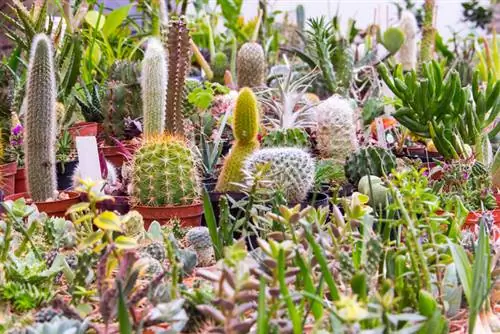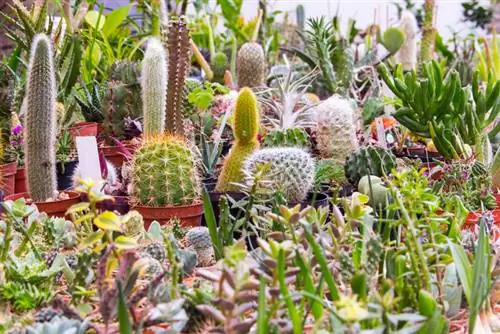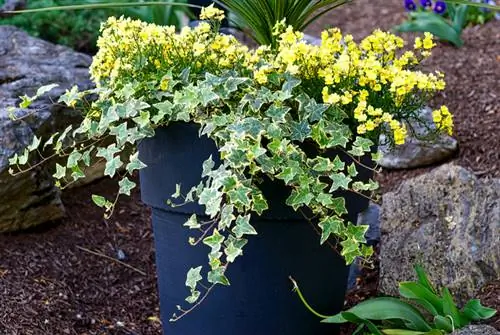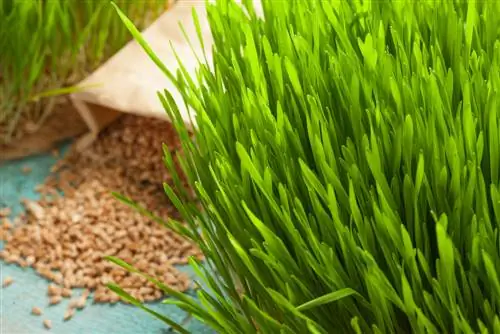- Author admin [email protected].
- Public 2023-12-16 16:46.
- Last modified 2025-06-01 06:02.
Among more than 1,800 cactus species, you can find tiny spiny dwarfs measuring 1 centimeter as well as majestic specimens up to 16 meters high. The most beautiful cacti also delight with their lavish flowers. We have looked around the realm of succulent survival artists and put together 20 recommended cactus species for you.

Which types of cactus are recommended?
Cactus species vary in size and shape, from tiny 1 cm spiky dwarfs to 16 meter tall giants. Recommended species include Bishop's Cap, Greisenhaupt, Gold Ball Cactus, Devil's Pincushion, Prickly Pear Cactus and Barrel Cactus for indoor use, as well as hardy species such as Opuntia cymochila, Opuntia engelmannii, Echinocereus triglochidiatus and Escobaria roseana for outdoor use.
Small cactus species up to 100 cm tall
With their bizarre silhouette and breathtaking flowers, the following cacti in pots on the windowsill stand out:
- Bishop's hat (Astrophytum), demanding cactus with a height of 20 to 40 cm and a summer flowering period
- Greisenhaupt (Cephalocereus senilis) scores with 40 cm high columns and silvery-white coat
- Gold ball cactus (Echinocactus) impresses with its spherical body and gold-colored, strong thorns
- Devil's pincushion (Ferokaktus acanthodes) reaches a whopping 30 cm diameter at a height of up to 100 cm
The stars among the cactus species are undoubtedly the prickly pear cacti (Opuntia). They are available with and without thorns, with a columnar, cylindrical or richly branched body shape. Above all, Opuntia bloom in beautiful colors that are in no way inferior in beauty to flowering perennials. In the right location, the cacti give their gardener edible fruits after the flower festival.
Barrel cactus - the popular delicacy of Mexico
It's not just the fruits that numerous cactus species boast. The barrel cactus (Ferocactus hytrix) can be discovered at every weekly market in Mexico. The spherical plant is divided to candied the pieces. It's not just children who are crazy about the sweets. However, the radially arranged thorns must be carefully removed beforehand.
Cacti for hanging baskets
Where thorny tendrils dangle casually, the following types of cactus are useful as exotic room decorations:
- Desert cactus (Aporocactus) with 70 cm long tendrils and red flowers from March to June
- Coral cacti (Rhipsalis) thrive without thorns with leaf-like, long shoots that bear many flowers in spring
- Leaf cacti (Epiphyllum) are characterized by 60 cm long, 5 cm wide tendrils and two flowering periods
- Snake cactus (Selenicerus grandiflorus), the queen of the night with fragrant flowers and long, slender shoots
One of the best-known cactus species cannot be identified as such at first glance. The Christmas cactus (Schlumbergera) puts on its red flower dress in the middle of Advent and Christmas. As a leaf cactus, the popular houseplant does not have any prickly reinforcement and is only covered with delicate bristles. Thanks to its hanging shoots, the Christmas cactus is equally suitable for hanging baskets and pots.
Types of cactus that reach to the ceiling
If you are flirting with a cactus, which forms the visual hotspot in your living room design, the following species will come into focus:
- Columnar cactus (Cereus), the superlative cactus species with up to 10 m height and 2 cm long thorns
- Silver candle (Cleistocactus), the slender beauty with a height of 150 to 180 cm and carmine-red, 12 cm flowers
- Farmer cactus (Echinopsis) produces numerous columnar shoots and blooms from April to September
- Candelabra cactus (Pachycereus pringlei) quickly reaches a height of 120 cm in full sun indoors
The undisputed giant in the cactus kingdom is the candelabra cactus Carnegiea gigantea. In the wild it reaches a height of 16 meters, weighs 8 tons and is 200 years old. It was only at the age of 75 that the giant branches for the first time at a height of 2 meters. His first heyday only took place after his 90th birthday.
Hardy cacti for beds, rock gardens and dry stone walls
They actually exist, the hardy cactus species for imaginative planting in your outdoor area. The following species have developed an ingenious strategy to survive bitter frost unscathed. The plants reduce the amount of cell sap and at the same time increase the s alt content, so that they have their own antifreeze.
- Opuntia cymochila: height 60 to 90 cm with blue-gray limbs and frost-resistant down to -25 degrees Celsius
- Opuntia engelmannii: growth height up to 100 cm, yellow flowers and edible fruits and hardy down to -22 degrees Celsius
- Echinocereus triglochidiatus: Tiny hedgehog cactus with a height of 1 to 5 cm and robust winter hardiness down to -20 degrees Celsius
- Escobaria roseana: Picturesque, 20 cm tall ball cactus with red flowers in summer and hardy down to -20 degrees Celsius
If you want a head-high, hardy cactus for the garden, the roller cactus (Cylindropuntia imbricata) is a good choice. It stretches up to 200 cm towards the sky and boasts purple, yellow or pink flowers. Over the years, the cactus species increasingly branches out and takes on a shrubby to tree-like shape. Planted in a row, a hedge is formed that reliably ward off uninvited guests.
Tip
Did you know? At the beginning of their evolution, cacti had leaves rather than thorns. Only later did the leaves curl up to reduce evaporation in the hot desert climate. At the same time, the cacti with their thorns sought to protect themselves against herbivorous animals. Thanks to this clever strategy, the plants can do without toxic ingredients in order to successfully defend themselves.






